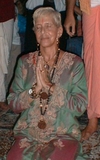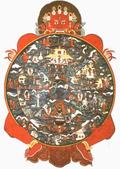I should explain....
Ma Jaya Sati Bhagavati is spiritual leader of Kashi Ashram, in central Florida. She is also an important AIDS activist – which is how I met her in the late 1980s (I think it was 1989). One of her followers in Los Angeles was also my AIDS Project Los Angeles phone buddy – that is, the guy who checked up on me, made sure I went to the doctor, etc.; so when she visited Los Angeles I went to meet her.
It was entirely amazing. I tend to worry a bit about institutionalized spirituality, and to avoid it when I can; but she not only a remarkable woman and teacher, she is also frankly a bit of a rebel – think of some of those 'wild' teachers famous in Zen and Sufism, who don't act restrained and saintly, and clearly don't fit into a well-behaved and socially 'correct' milieu. Ma was, and is, startlingly real, full of strong feelings and powerful intuition; one of the main ways she teaches is by the startling, even shocking, revelation – she will easily and definitely tell people what they need to know, even when it's not a comfortable thing to hear.
She became an important part of my life throughout the 1990s, as she frequently visited Los Angeles and San Francisco, and I visited the ashram several times on my own; I think this poem came from a week-long visit. The ten sections end up being occasional portraits of Ma in several of her aspects, and also of a few of the people around her – Bina, Rudra Das, Shambo – although it's unfortunate that I didn't write about some of my other friends there, especially Omkar Naga. Of course what it's really doing is trying to link up all those portraits into a sense of what Ma is like (from my point of view), and what it's like to stay with the people who live on the ashram.
This came up in the last few days also because D– was recently in India; when he visited yesterday he was showing photographs of his hotel, the school, the people, elephants in the street – all in an effort to convey the visceral, immediate experience of this strongly flavored culture, this place where feeling, music, spirituality, awareness, and philosophies that link up all of those are respected and in fact omnipresent. Different, of course, than visiting an ashram in central Florida; but I sympathized with what he was trying to do, and even with how hard it was to achieve – how can we convey the vivid three-dimensional reality of cultures that seem more honest, more real than our everyday lives?
I suppose that's what the poem is trying to do....







